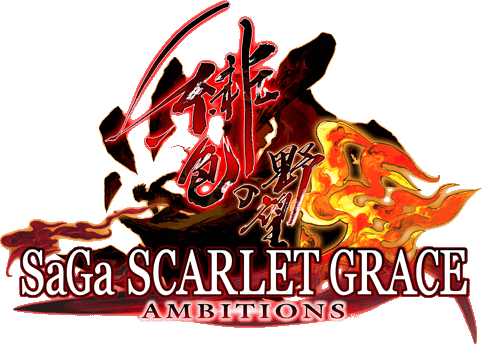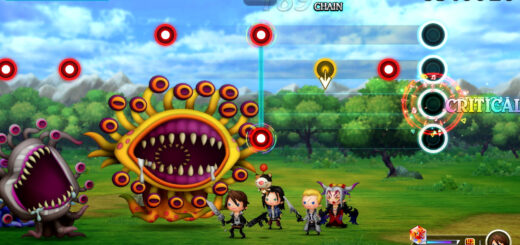SaGa Scarlet Grace: Ambitions Review
The SaGa series has been around for a long time, starting its humble beginnings as Final Fantasy Legend on the Game Boy. From there, it spawned a few sequels until Unlimited Saga in 2002 for the PlayStation 2, but then it was a hefty wait for a brand new, fully fledged title until SaGa Scarlet Grace released for PlayStation Vita in Japan in 2016. It seemed destined to stick there, but the reception of Romancing SaGa 2‘s remake has given new life to the series, and western RPGamers finally have the chance to play the most recent title in its enhanced form, SaGa Scarlet Grace: Ambitions. SaGa games have always been about experimenting with something new and deviating from their RPG competitors, and Scarlet Grace is no different.
The intro sets the story for much of the game. Godlike beings called Celestials governed many aspects of human life, but one of them, the ‘Fire Bringer’, diverged from the rest by giving mankind the ability to use fire, fighting against his brethren. Subsequently banished as a result of these misdeeds, he returned every 150 years to wage war on the world, and each time the Celestial-supported Empire rose up to defeat him. Eventually the Empire succeeded in killing the Fire Bringer, but at a heavy cost as the Emperor died and the world was plunged into war and turmoil. In the wake of these events, new nations have formed, and, as the game begins, four characters emerge to change the fate of the land.
The game starts by asking players a series of questions, and how they are answered determines the protagonist from four options: Urpina, Taria, Leonard, or Balmaint. Each brings a completely different setting and adventure with many events offering branching paths with many helpful or devastating results. What happens is often down to the player’s actions, and this divergence is one of the story’s greatest strengths, requiring multiple playthroughs to view all of the events, thus making it a highly replayable game. The narrative and dialogue do well to build the world and its lore, and each region has its own history and story to tell. Unfortunately, most of the supporting cast outside of the main characters are rather generic with little to no personality outside of their assigned combat roles.
The gameplay is the driving force of the game. Doing away with movement within dungeons and towns, exploration revolves around traversing the beautifully illustrated world map. Story events, enemy encounters, and treasure-hunting all occur on the map, making it in essence the actual dungeon. Players simply walk over to landmarks to converse with NPCs, activate story scenes, open up a small menu, or initiate battles. Sometimes, there are monsters walking on the maps, and players can engage them for battle. Those who love carousing around towns and spelunking in dungeons may find this aspect disappointing, but the lack of it helps to bring about the game’s greatest strength: combat.
Whilst the combat looks like the typical turn-based affair upon first glance, it has a deep level of strategy and options for players to experiment. The party begins each fight with a predetermined number of Battle Points, or BP, and each action or Tech ability consumes these valuable BP. Players will need to weigh their Tech use carefully, as strong Techs can quickly drain the party’s BP, leaving other characters unable to act. Therefore, players must strategically allocate their valuable BPs into the appropriate Techs or characters for each turn. Status-inducing Techs such Confusion, Poison, Sleep, or Provoke are not only extremely useful in this game, but are often required to win battles, since relying on just basic tactics such as straight attacking and healing is not enough. Increasing stats helps and players can improve their chances by frequently using Techs to level them up to be more powerful, but like previous SaGa games, attribute gains and the learning of new skills are generally up to the whim of fate.
On top of balancing out how to use Techs in battle, combat is further deepened by United Attacks and the Timeline system. Party members and enemies have a set order for each of their turns, displayed in a row at the bottom of the screen. The Timeline can be manipulated with certain Techs, allowing for useful effects such as pushing an enemy’s turn to the back of the queue and letting players maximise damage output whilst mitigating enemy attacks. Another way to manipulate the Timeline system is to aim for for a United Attack, which unleashes a combined powerful attack and essentially gives the party an extra attack. Not only does this often vanquish an extra foe without consuming a party member’s turn or BP, but each party member that participated in the United Attack will receive reduced cost of BP for their techs on the next turn. Enemies can also perform United Attacks, so players much further plan against such an onslaught by studying the Timeline system.
The combat of Saga Scarlet Grace: Ambitions resembles chess in many ways. The battles require players to focus and plan ahead accordingly, and a simple miscalculation or a well-placed Tech can take things in a whole new direction. On top of the deep strategic elements of combat, players must keep in mind character skills, stats, spells and equipment in order to survive. Many battles are close, and sometimes luck plays a factor in the outcome, such as when a character learns a new skill and executes an extra attack. This game’s turn-based combat system stands in a class of its own, and those looking to blunder through fights with traditional RPG strategies will quickly find themselves overwhelmed.
Kenji Ito’s soundtrack is of high quality, even compared to his past arrangements with the SaGa and Mana series. The opening track, complete with operatic vocals, sets the stage for a powerful introduction, followed by several quality tracks featuring similar expressiveness to the Romantic era of music. Like in the Mana series, some tracks have strong rock-infused themes with heavy drumming and electric guitars carrying the melody. The battle music pales in comparison and seems rather unremarkable compared to the rest of the content, yet there are many different battle themes, some depending on which character the player is using at the time. Despite the occasional mediocre track, the game has many memorable melodies that show Kenji Ito still has a deep pool of creative talent.
The graphics for SaGa Scarlet Grace: Ambitions shows its PlayStation Vita origins. However, the impact varies. On the overworld map, the graphics are gorgeous, resembling a colourful fairy-tale book with key-locations popping up as the player traverses near, resembling the turning of a page on a pop-up book. On the other hand, the battle backgrounds, enemies, and character designs are much more noticeably designed for previous hardware and take the biggest hit. They’re certainly not hideous, but look like something out of a past era. The overall art style, especially in the illustrated town backgrounds and character portraits, at least puts an interesting and unique stamp on its visuals.
SaGa Scarlet Grace: Ambitions is an ambitious game that hides a lot of content beneath its surface whilst offering one of the best combat systems and strongest replay values for an RPG. Its main problem lies in its accessibility to the average RPGamer. The game’s difficulty can be unforgiving at times, and it’s definitely not a game for everyone. But those who like endless party customisation, good battle strategies, rich world-building, and choosing how the adventure plays out will find a very rewarding title here. The SaGa series has always been about going against the grain and innovation, and this one outdoes all its predecessors in that regard and raises the bar for any new entries to come.
Disclosure: This review is based on a free copy of the game provided by the publisher.


Deep level of strategic combat
Great soundtrack
High replay value
Many branching events
Difficulty may turn away casual players
Not appealing for everyone
Mediocre graphics









This was my GOTY of 2019. More people should give the game a shot.
It really is a great game, and I have had issues with some of the games in the series.